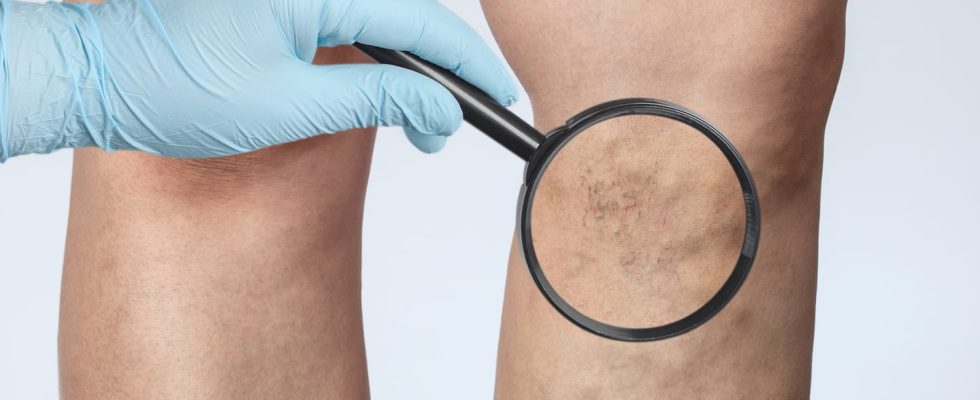Swollen ankles, heavy legs, varicose veins… Venous insufficiency (bad return) ruins the lives of nearly 18 million people in France. Especially women. (First) symptoms, cause, treatment.
Venous insufficiency corresponds in everyday language to poor venous return. It affects older women more easily. Among the complications: phlebitis and venous thrombosis. What are the first symptoms a venous disease? What causes venous insufficiency? Is it good to wear compression stockings? How to treat it?
What is the definition of venous insufficiency?
Venous insufficiency is a circulation disorder in the veins legs. Women are more affected by this pathology, the frequency of which also increases with age. 70% of women over 80 are affected in this way. Phlebitis and peripheral venous thrombosis also increase the risk of occurrence of venous insufficiency. “There are two topographical types ofvenous insufficiency: superficial or deep. The superficial is the “visible” one, varicose veins”. The deep is that of acute phlebitis with a risk of transition to chronicity in the waning”says Dr. Adrien Boutin.
Who are the people at risk of having venous insufficiency?
“Venous insufficiency has a character hereditaryespecially in women. Age, pregnancy, obesity, a profession exercised standing (in orthostatism), sedentary lifestyle and some sports may also be involved”, explains the vascular surgeon.
What are the symptoms of venous insufficiency?
A series of symptoms generally accompany venous insufficiencies: s
- Feeling of heavy legs, especially at the end of the day, calmed by elevation or walking
- Leg edema and especially ankles and calves
- Tingling or feeling of numbness
- Appearance of muscle cramps
- Appearance of telangiectasias
- Appearance of varicose veins
- Change in skin color
- Appearance of ulcers at an advanced stage.
Nevertheless, some venous insufficiencies do not result in any symptoms.
What causes venous insufficiency?
Venous insufficiency is the consequence of an alteration of the wall of the veins which results in insufficient return of blood to the heart. The blood stagnates in the lower limbs, causing heaviness and pain.
What are the complications of venous insufficiency?
“The existence of significant venous reflux leads to sometimes severe hyperpressure, responsible for microcirculatory disorders, in particular capillaries, at the level of the extremities of the lower limbs. The evolution towards chronic venous insufficiency with the presence of trophic disorders is the consequence of tissue decompensation resulting from capillary dysfunction”, emphasizes the specialist.
The interrogation already makes it possible to orient the diagnosis. The doctor can inspect the legs looking for varicose veins and testing the tone of the veins. The main test for diagnosing venous insufficiency is venous echo-doppler of the lower limbs. This examination using the technique of ultrasound with a probe emitting ultrasound is coupled with a Doppler examination which allows the study of blood flow.
The treatment of venous insufficiency consists of:
- to wear compression stockings
- to take venotonic drugs
- to carry out regular lymphatic drainage to fight against edema and heavy legs.
- It is also possible to treat the defective vein(s) by sclerotherapy. This treatment involves injecting a sclerosing product in a varicose vein to delete it.
- It is also possible to have the offending vein removed. by surgery (stripping). “There are also endovenous laser treatment techniques, but above all by radio frequency (a technique widely used today). It consists of puncturing the varicose vein and sclerosing it using heat from the “inside” under local, general or local anesthesia under hypnosis. These techniques are often accompanied by a supplement by stripping the remaining small varicose branches.notes the vascular surgeon.
How to prevent venous insufficiency?
It is possible to prevent, but also to relieve venous insufficiency by practicing a “gentle” sports activity (cycling, walking, running, swimming, gymnastics, golf) And by elevating the lower limbs at night (by raising the legs of the bed, for example), but also losing the habit of crossing your legs while sitting and avoiding exposure to heat, including underfloor heating. “It is also advisable to wear suitable footwear: the heels must be between 3 and 5 cm. At the same time, it is essential to fight against obesity but there is no particular diet to adopt. Finally, you should know that contraception is not contraindicated in venous insufficiency”, concludes the specialist.
Thanks to Dr Adrien Boutin, vascular surgeon at the University Hospital of Rouen.
